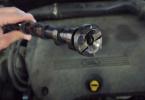Worm gearboxes are actively used in mechanical engineering. For example, they are often used in the installation of machines to ensure silent operation and the possibility of a sharp change of speed
This type of gearbox needs regular lubrication, without which the efficiency of the device will decrease sharply, and it will wear much faster. To solve this problem, there are special oils for worm gearboxes, designed to increase the efficiency of the unit and its service life.
Effect of lubrication gear
Butter for worm gearboxes allows you to improve the operation of the device at once in several directions, including:
- protection against excessory friction, temperature drop and fast wear;
- an increase in efficiency (power transmission is improved, since losses due to high-quality lubrication reduced);
- extending the duration of the gearbox.
Oil from time to time you need to change. With a long use, it loses its properties, impurities are formed in it, and lubricating capabilities deteriorate. With a timely replacement of oil, the device will serve you for many years and will provide excellent performance.
How to choose oil
The choice of worm gearboxes depends on the device itself and on its performance: temperature and intensity of use. There are many oils for different types of gearboxes that differ in their parameters. For example, oils on a synthetic basis are suitable for low temperatures, for higher - on mineral. Among the mineral oils, there are also options that will protect the gearbox from other aggressive impacts, such as excessive moisture.
Our offer
Klüber Lubrication oils are distinguished by high quality, variety of range and operational characteristics. The company has existed on the market for over 80 years and has deserved recognition as a manufacturer of lubricants of high quality and reliability. Kleber Lubricheishn LLC is the only official representative of the company in Russia. We distribute reliable German products in the Russian Federation, for the quality of which the manufacturer swore.
To date, worm mechanisms have been very widespread, since they are part of various mechanisms. The main purpose is to directly transmit effort from the electric motor to the direct executive body. The principle of operation is usually based on the interaction of two or several elements that are constantly engaged. Too long exploitation under load and low oil level in the gearbox cause abrasion of the main elements. That is why it is important to choose the right oil for worm gearboxes and spend it timely replacement.
Periodicity of oil replacement in reducer
A rather common question can be called how often and why change the oil in the gearbox. Most professionals recommend replacing in accordance with the spent resource. For automatic transmission, this indicator is 30 thousand kilometers, in the case of mechanics, the indicator is 50 thousand kilometers.
Replacement is carried out at the following reasons:
- Over time, due to overheating and other impact, the main properties of oil deteriorate. An example can be called a decrease in lubricating properties and many other points. That is why the device will not last for a long time.
- Natural wear of metal products causes a large amount of metal chips in the composition. It causes severe heating due to the resulting friction.
- The deterioration of the basic properties of the worm mechanism is caused by overheating and increased wear of the main elements.
- Over time, the amount of lubricant material decreases naturally. At the same time, manufacturers are not recommended to conduct mixing with a new one, as it will only reduce the main performance characteristics.

Directly the technical oils themselves are liquid petroleum products with different kinds of synthetic substances, as a rule necessary for a variety of industrial and technical needs. In industry, technical oils are used primarily for the proper operation of this or that equipment. Technical oils on oil lubricating oils and oil lubricating liquids are divided. As a rule, lubricant oils include such types of oils as turbine types of oils used to lubricate various turbine bearings, universal oils intended for special sliding guides that have an increased viscosity, ship oils intended for the process associated with the formation of an emulsion, Compression-type oils used usually used for deep cleaning of a particular equipment, as well as oils, as a rule, for all sorts of machine and aircraft engines.
Separately, I would like to tell about gear oils, which significantly extend the life of general industrial gearboxes, and some cases allow to maintain unique equipment based on removed gearboxes, such as RCD-250, RCD-350 and RCD-400.
Typically, where the use of different lubricating oils is impractical, certain consistant lubricants are used, which in turn are the so-called half-product product of the dispersing process and an additional additive in a special liquid lubricant. Due to the use of directly the consistent lubrication itself, the procedure for the delivery of this lubricant is carried out to various hard-to-reach places, which for any reason can not penetrate lubricating oils. This type of lubricant is used in worm gearboxes RCHN-180, RFP 180 or RCCH-100.
Speaking of special lubricating liquids, it should be noted that they, as a rule, combine the properties inherent in standard cooling fluids and thread or other lubricants. The lubricating and cooling fluids themselves provide not only effective heat exchange, but also the protection of various surfaces from corrosion. Due to their special properties, there is a rather deep cleaning of a particular equipment for a relatively short period of time. As a rule, lubricating and cooling fluids include: different kinds of pure mineral oils, which in turn organic compounds of such chemical elements as phosphorus, chlorine, and sulfur, various concentrate solutions in which surfactants are present in the complex with Polymers having low molecularities and special water emulsions to which, as a rule, include mineral oils and emulsifiers with additives.
Determine the oil brand for the worm-cylindrical gearbox (Fig. 7.1) according to the specified values \u200b\u200bof the main parameters of the toothed and worm gear.
Fig. 7.1. Curious-cylindrical gear diagram:
1,2,3 - presenter, intermediate and slave shafts; 4 - worm; 5 - worm wheel; 6.7 - gear and cylindrical steps wheel; N 1 N 2 N 3 - the frequency of rotation of the leading, intermediate and slave shafts of the gearbox
Options for tasks
| Worm-gear | Gear |
|||||||
| D 1, mm | N 1, rpm | γ,° | Σ H, MPa | D 3, mm | N 2, rpm | N HV, MPa | N V V MPa | |
| 1 | 32 | 2900 | 7,125 | 190 | 80 | 360 | 230 | 236 |
| 2 | 54 | 2815 | 23,962 | 360 | 90 | 400 | 240 | 246 |
| 3 | 30 | 2860 | 21,801 | 250 | 140 | 410 | 250 | 257 |
| 4 | 36 | 2840 | 18,435 | 290 | 100 | 400 | 260 | 271 |
| 5 | 40 | 2910 | 8,130 | 280 | 60 | 360 | 270 | 285 |
| 6 | 32 | 2850 | 3,576 | 300 | 80 | 390 | 283 | 301 |
| 7 | 64 | 2880 | 14,036 | 290 | 100 | 360 | 230 | 236 |
| 8 | 84 | 2940 | 4,764 | 320 | 85 | 420 | 240 | 246 |
| 9 | 60 | 2810 | 11,310 | 300 | 95 | 400 | 235 | 241 |
| 10 | 42 | 2920 | 6,462 | 265 | 80 | 415 | 240 | 246 |
| 11 | 50 | 2940 | 15,945 | 280 | 100 | 365 | 250 | 257 |
| 12 | 40 | 2880 | 14,036 | 260 | 95 | 410 | 240 | 246 |
| 13 | 35 | 2945 | 26,565 | 250 | 75 | 365 | 235 | 241 |
| 14 | 55 | 2945 | 7,125 | 260 | 75 | 420 | 230 | 236 |
| 15 | 40 | 2840 | 5,711 | 300 | 110 | 405 | 230 | 236 |
Oil viscosity selection
The values \u200b\u200bof friction coefficients for various materials are reduced with increasing viscosity of lubricant material. However, simultaneously increases hydromechanical losses for mixing it. Therefore, the issue of the correct choice of viscosity of the oil is reduced to the definition of some optimal value based on the experience of manufacturing and operating machine components, as well as recommendations of the theory of lubrication.
The viscosity of oil lubrication with steel teeth is approximately determined by Figure 7.2 (shaded zone) depending on the factor:
![]() (7.1)
(7.1)
where - the hardness of the Vickers of the active surfaces of the teeth;
![]() - contact voltages, MPa;
- contact voltages, MPa;
- District speed in engagement, m / s.

Fig. 7.2. The viscosity of unallocated oil oils
For steel gears
At ambient temperature below plus 10 ° C and for high accuracy gear, the smallest viscosity value should be taken (in the shaded zone). The upper limit is recommended to be prescribed with a gear wheels from the steel of one brand or if at least one of them is made of nickel or chromonichel steel. In multistage gearboxes with a total oil bath, the viscosity of the oil takes the intermediate between the required for thexious and high-speed steps.
Approximate viscosity values \u200b\u200bfor worm gears are determined by Figure 7.3. (Shaded zone) depending on the value. :
 , (7.2)
, (7.2)
where contact voltages for the crowns of the wheels of tin bronze, MPa
Sliding speed in engagement, m / s;
υ S \u003d 5.24 · 10 -5 D 1 N 1 / COSγ, (7.3)
where D 1 is the diameter of the dividing circumference of the worm, mm;
n 1 - Worm rotation frequency, rpm.

Fig. 7.3. The viscosity of unalloyed oil oils for worm gears
In gearboxes, gearboxes, machines and other devices containing engagement, rolling bearings are lubricated by the same lubricant as the engagement. If the lubricant is selected based on the working conditions of the bearings, it is recommended to assign a viscosity (10-30) 10 -6 m 2 / s at operating temperature. More viscous oils are used to lubricate highly loaded bearings with low speed, roller spherical, conical and thrust bearings (due to increased friction of gliding rolling on the track and separator).
In physical state, lubricants are divided into liquid, plastic and solid. Liquid oil oils find the greatest application. These include industrial overall oil oils and special, the scope of which is reflected in their names: turbine (lubricant bearings and auxiliary mechanisms of turbo units), aviation, transmission, automotive, etc. Information on the viscosity and temperature of the frozen of the most common oils are shown in Table 7.2.
Table 7.2.
Oil lubricants
| Mark Oil | Frozen temperature, ° C | Mark Oil | Kinematic viscosity υ · 10 -6, m 2 / s, at 50 ° C | Frozen temperature, ° C | ||
| Industrial (GOST 20799-88) | Turbine (GOST 32-74) |
|||||
| I-8A | 6–8 | –20 | T 22. | 20–23 | –15 | |
| I-12A. | 10–14 | –30 | T 30. | 28–32 | –10 | |
| I-20A. | 17–23 | –15 | T 46. | 44–48 | –10 | |
| And-25a | 24–27 | –15 | T 57. | 55–59 | – | |
| I-30A | 28–33 | –15 | Aviation (GOST 21743-76) |
|||
| I-40A. | 35–45 | –15 | MS-14 | 92 | –30 | |
| I-50A | 47–55 | –20 | MS-20 | 161 | –18 | |
| I-70A. | 65–75 | –10 | MK-22. | 192,5 | –14 | |
| And-100a | 90–118 | –10 | MS-20S. | – | –18 | |
Note. Industrial oils are selected for general purpose gear
EXAMPLE Calculation:
Determine the oil brand for the worm-cylindrical gearbox. The speed of rotation of the drive shaft of the gearbox N 1 \u003d 2860 rpm, the diameter of the dividious circumference of the worm D 1 \u003d 50 mm, the angle of raising the turns of the thread of the worm γ \u003d 21,801 °, the working contact voltages σ h \u003d 210 MPa. The speed of rotation of the shaft gear gear N 2 \u003d 286 rpm, the diameter of the divisory circle of gears D 3 \u003d 80 mm, the hardness of the gear material H HB \u003d 240 MPa.
Worm gear is a mechanism for transmitting rotation between shafts through a screw (worm) and a worm wheel conjugate. Using worm gears - an inexpensive way to ensure high speed of single-stage gearboxes. These gearboxes are withstanding numerous launches and stops, changing loads and are used in many types of food industry equipment.
Usually in mixers or packaging machines, worm gears are placed deep inside the processing equipment, and in the drives of conveyors are mounted on top, on weight. Such a location makes it difficult to access them when carrying out maintenance. As a result, worm gearboxes are contained in unsatisfactory state, which leads to damage and premature wear of the drive details.
In order to minimize the need for maintenance and related costs, designers developed a disposable gearbox, which are filled with standard polyalphaolefin (PAO) oil. Such gearboxes are capable of working within 2000 hours. With continuous operation, they require replacement every 12 weeks.
An alternative to replacing gearboxes is the use of synthetic gear oil with food tolerance. It provides excellent long-term lubrication at high and low temperatures, has a low evaporation and compatible with the equipment designed for the use of mineral oils.
It is known that the main part of the worm gear drive is made of bronze. That is why, in order to avoid corrosion in the standard oil formula, anti-grade additives are contained in minimal amounts, and the separating properties are provided only at the expense of high viscosity oily film. Butter Molykote. L-1146FM contains a phosphorus-based anti-wear additive, which does not cause corrosion of bronze parts of the worm gear actuator and meets the requirements for lubricant materials with food tolerance. In contrast to the materials obtained by traditional distillation processes, this synthetic oil is made due to the combination of smaller molecular "building blocks" in accordance with the specified parameters of the performance and in order to minimize the amount of impurities.
Due to its formula, synthetic oil with food tolerance Molykote. L-1146FM helps to reduce the friction of the gearbox parts and, as a result, an increase in the permissive period.
Experience use Molykote. L-1146FM At the factories of the food industry proved its effectiveness: the service life of disposable gearboxes has increased more than four times, i.e. Instead of 2000, I began 9000 hours.
According to the provisions of the Office for Food Control and Drug Administration (USA) Oil with food admission Molykote. L-1146FM is approved for use when possible random direct contact with food. In addition, it meets the requirements of the US Department of Agriculture and can be applied at meat processing factories and poultry industry.



